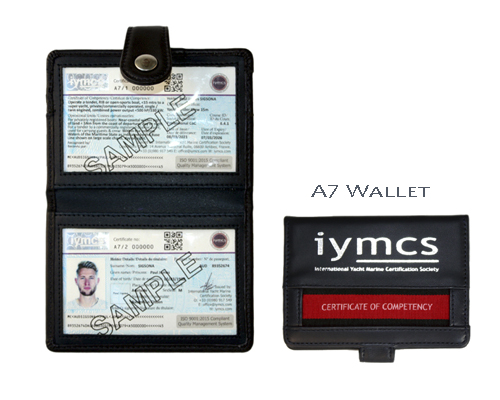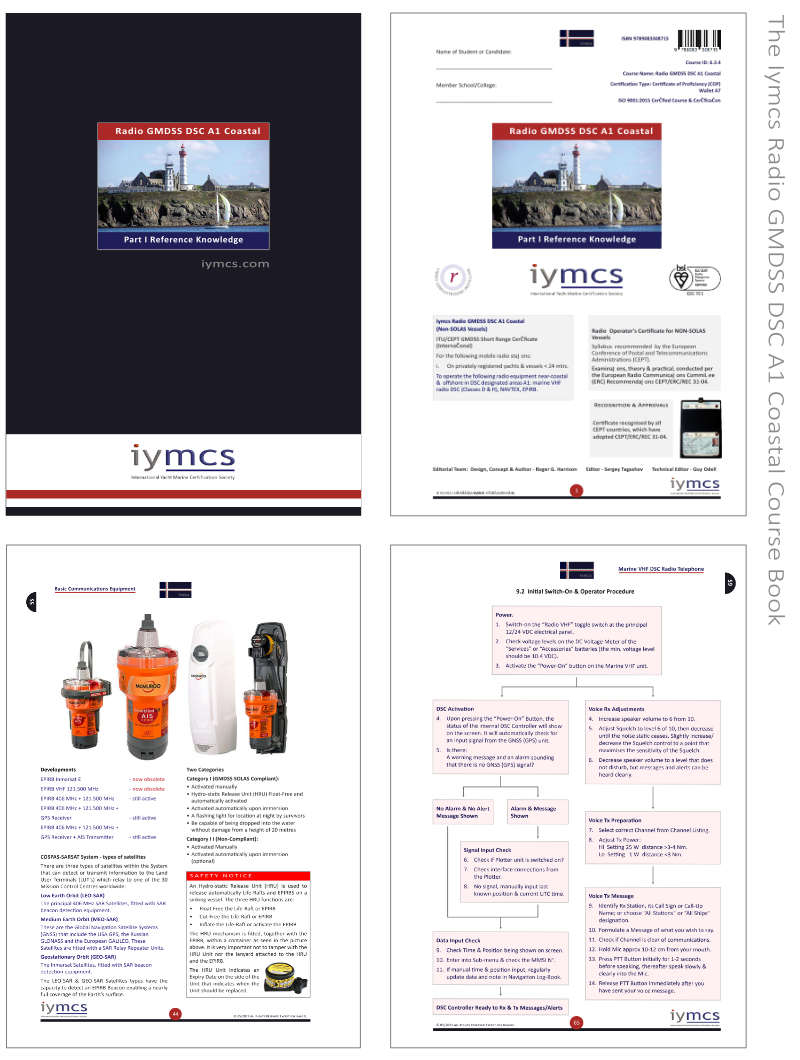
| General Details |
|---|
| Course & Certification:
ID: 6.3.4 Description: Radio GMDSS DSC A1 Coastal Certification type: Certificate of Competency (CoC) ISO 9001:2015 compliance course & certification. |
| Course Length:
A total of 24 hours consisting of; Pre-Course study = 1 hour; |
| Capacity of certification:
ITU/CEPT GMDSS Short Range Certificate (International) For the following mobile radio stations: On privately registered yachts and vessels <24 metres: To operate the following radio equipment near-coastal in DSC designated area A1: marine VHF radio DSC (Classes D & H), EPIRB, NAVTEX. |
| Recognitions & approvals:
Certificate recognised by all CEPT countries which have adopted CEPT/ERC/REC 31-04. |
| Reference Standards:
Radio Operator's Certificate for NON-SOLAS Vessels. |
| Certification Revalidation:
Required every 5 years with the undertaking of a 1.5 hours refresher course on a 1-station simulator. |
| Sea-time requirements:
None. |
| Certification issuing requirements:
None. |

The custom-designed Iymcs wallet type certification is stylish and practical. The wallet outer is made of real leather with a sythentic interior that is resistant to water and protects the certificates. It is wallet size, comfortable to carry around, it is not too small to lose like the credit-card style type certifications you often see now.
The Iymcs Certifications are printed to ISO 9001:2015 standards, are dual-language and feature extensive security features to security level 3 (Government passports & national Iidentification documents are security levels 1 & 2) and can be used as a personal ID in daily situations. (Nb. It cannot be used instead of a passport/national identity card).
The Iymcs Radio GMDSS DSC A1 Coastal Course focuses upon safety and general communications for recreational vessels and craft operating in Coastal Waters (30Nm from a safe haven or 60Nm between two safe havens) or in archipelago areas or on inland seas & waterways lakes, canals, rivers etc).
The Course covers the fundamentals of GMDSS, the basic communications equipment and Distress, Urgency and Safety communications. The theoretical has been kept to the minimum, so as to place an emphasis upon the practical usage of the Marine Radio VHF DSC and other marine radio equipment by undertaking practical exercises, using a simulator or actuam on-board units, enabling you to gain the know how and confidence to call-up and communicate with:
MRCC/MRSC/JRCC |
Coastal Radio Stations |
Other vessels |
Marina office or mooring harbour master |
Marine Police & Douanes |
The Iymcs Radio GMDSS DSC A1 Coastal Course Book is divided into 2 Sections, namely: Part I Reference Knowledge and Part II Operating Procedures.
Part I covers the theory and underpinning knowledge about a particular equipment, process, procedure etc.
Part II covers the installation, testing, radio regulations and operating procedures of the same equipment.
It is a smart way of learning, gain first all the general knowledge, then put it into practice.
The course book design features short blocks of text, safety notices and key notes that all make for easy reading and translation. Flow diagrams appear throughout with supporting images.

An important aspect to this Iymcs Course is that it covers in detail the set-up, maintenance and operation of; vessel EPIRBs, NAVTEX receivers and AIS receivers & transponder units (SARTS are not covered in this Course). The all-important battery power supply, charging and testing is covered in detail under SOLAS requirements.
The underlining success of this Course is to teach you how to communicate effectively with confidence, using the recommended procedures and phonetic words fluently in maritime English: To help non-native English speaking students/candidates that may have difficulties with this, English pronounciation exercises are also included in the Course.

Our Society, the 'International Yacht Marine Certification Society" (Iymcs) operates its entire operations under a Quality Management System
(QMS) that is in compliance with the International Standards Organisation (ISO) 9001:2015 amended and is certified by the British Standards Institute (BSI) Netherlands.
Part of this compliance involves full auditing of procedures by external (BSI) and internal auditors.
This is an important reference and enables the Society to gain recognitions from maritime administrations and marine industry bodies alike.
The QMS together with the ISO, ensures that Iymcs and its Members operate to the highest standards possible. All the Iymcs courses, and more importantly the
Certifications that we issue, come under our BSI ISO 9001:2015 certification.
This practice is most unusual to see for such courses and certifications. It ensures a uniform and consistent quality standard throughout the Society's operations.
| Scandinavia 580,-EUR | Northern Europe 580,-EUR | United Kingdom 395,-GBP |
| Southern Europe 490,-EUR | Middle East 620,-USD | North America 450,-USD |
| Prices exclude: course book,certification costs,personal traveling costs,course food and course accommodation. | ||
( Vers. 1.2. CEPT/ERC.) Click-on '+' to see Syllabus.
Introduction & Objectives of the course. History of Marine Radio Communications & Distress Mayday. Science of Radio Waves (A1.1.3). Radio Wave Propagation (A1.1.3). Tx & Rx Ranges (A1.1.3). Marine VHF Radio Telephone Installation (B3.3.2 & 3.3). Antenna Coaxial Cable & Deck Connectors. Interfacing Connection to a Positioning Device (B3.3.2). GMDSS, ITU & SOLAS.
GMDSS Structure (A2.2.1). GMDSS Sea Areas (A2.2.1). SAR Organisation (A3.3.1 & A3.3.3). MRCC & MRSC (A3.3.2).
Radio Frequency and Bands. Simplex, Semi-Duplex & Full-Duplex Operations (A1.1.3). Channel types, Categories & Usages (A1.1.3). Transmission & Receiving Distances (A1.1.3).
Types of Aerials. Antenna Performance & Positioning (B3.3.1). Antenna Gain. Types of Antenna. Antenna Interfacing Units. WiFi Antenna Group. Lightening.
Marine VHF Radio - Mobile Station Units (B1.1.3). Marine Handsets & Microphones. Marine VHF Radio - Handheld Units (B1.1.3). Emergency Position-Indicating Radio Beacon (EPIRB) (C3.3.1 + C2.2.6 + C3.3.2). NAVTEX Receiver. Minimum Carriage Requirements for Pleasure Yachts & Craft <24m.
DSC - History & Development. Maritime Mobile Service Identity Number (MMSI). National ID - Maritime Identification Digits (B2.2.3). MMSI N°s - Ship Station (B2.2.3). MMSI N°s - Coast Station (B2.2.3). MMSI N°s - EPIRB AIS Beacons.
AIS - System. AIS - Channel & Frequency Allocation. AIS - On Board Equipment and Installation. AIS - Transceivers, Transponders & Receiver Units. AIS - Data Transmissions. AIS - Principal Functions and Cautionary Points. AIS - Data Error & Implications.
Principal Controls (B1.1.2). Initial Switch-On & Operator Procedure. Power Outputs. Dual-Watch, Tri-Watch & Scan-Watch (B1.1.1). Channel 16 (A1.1.3). Primary International Channels (A1.1.3). VHF Channels & Frequencies (A1.1.3). Adverse Meteorological Conditions. DSC System, Alert & Messaging (B2.2.2 & B2.2.4).
Ships Radio Station Licences. Radio Operator Certifications (E1.1.2). Types of Radio Stations (A1.1.2). ITU International & Regional Channel Lists (E1.1.2). ITU/GMDSS Regulations of Operations & Good Practices (E1.1.2). Vessel Identification (D2.2.1) & MMSI (B2.2.3). GMDSS Radio log (E1.1.2)
Official ITU & GMDSS Publications. International Code of Signals. Independently Published Yacht; Cruising Guides, Pilot books, Charts. UKHO Admiralty Sailing Directions. Electronic Charting Systems (ECS) Information Inserts/Boxes. Official Online Internet Resources.
The International Phonetic Alphabet (D1.1.5). International Marine Communications Procedure Words (D1.1.4). Communication Phrases Exercises. Phonetic Alphabet Exercises.
Com procedures -Ship to Ship (B2.2.1 & D2.2.1). Com procedures -Ship to MRCC or MRSC (A3.3.3 & D2.2.1). Com procedures -Ship to Coast Station (D2.2.2). Radio Procedures Cards. Traffic Lists.
Tender/Auxiliary Communications - VHF Handheld & Fixed (C3.3.3). Communication Ranges (C3.3.3). Message Relay. Battery Provisions (C3.3.3).
Distress Mayday Situation - Defnitions. Distress Mayday Situation - Determining. Distress Mayday - Alert & Message Content (B2.2.1 & C1.1.1). Distress Mayday - Tx Procedures (C1.1.1). Obligation to Assist a Vessel, Aircraft or Person/s in Distress. Distress Mayday - Response Procedures (A3.3.4 & C2.2.2). Distress Mayday - Relay Procedures (A3.3.4). Distress Mayday - Cancellation Procedures. Urgency Pan Pan - Definitions. Urgency Pan Pan - Tx Procedures (B2.2.1 & C1.1.2). Urgency Pan Pan - Response Procedures (A3.3.4). Urgency Pan Pan - Cancellation Procedures.
Reference Publications. Telemedical Advice Services (TMAS). TMAS Assistance - Patient and Information. Urgency Pan Pan (Medico/Medical) Message -Tx Procedures (D1.1.2).
Safety Sécurité Message - Categories (D1.1.3). Safety Sécurité Message - Content (B2.2.1 & D1.1.3). Safety Sécurité Message - Rx & Tx Procedures (C1.1.2 & D1.1.3).
NAVTEX - NBDP Principles (A4.4.1). NAVTEX - Message Format & Categories (A4.4.1). NAVTEX - Stations & Frequencies (E1.1.1). NAVTEX - Installation. NAVTEX - Set-Up & Operating Procedures (A4.4.1)
Marine VHF Frequency Guard Bands (C2.2.1 & C2.2.5). Guard Frequencies & Avoidance of Transmissions. Test Protocols & Procedures (C2.2.4). Cancellation Procedures for False Distress Alert Transmitted (C2.2.6). Prevention of Unauthorised Transmissions (C2.2.3). Distress & Urgency Channel 16 Frequency Blocked.
Installations & Power Sources (B3.3.3). Battery Management & Charging (B3.3.3). Battery Types & Maintenance (B3.3.3). Battery Configuration. Safety Requirements (B3.3.3). Basic Electrical Circuit Testing.